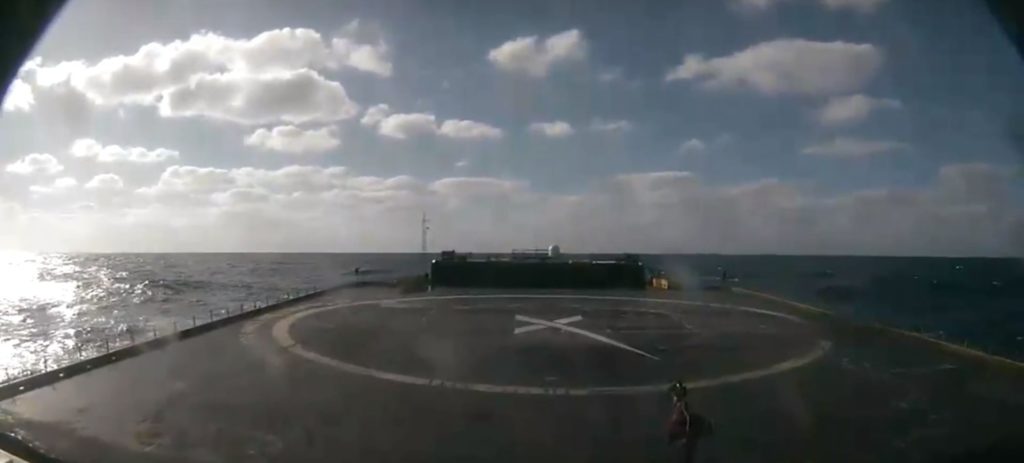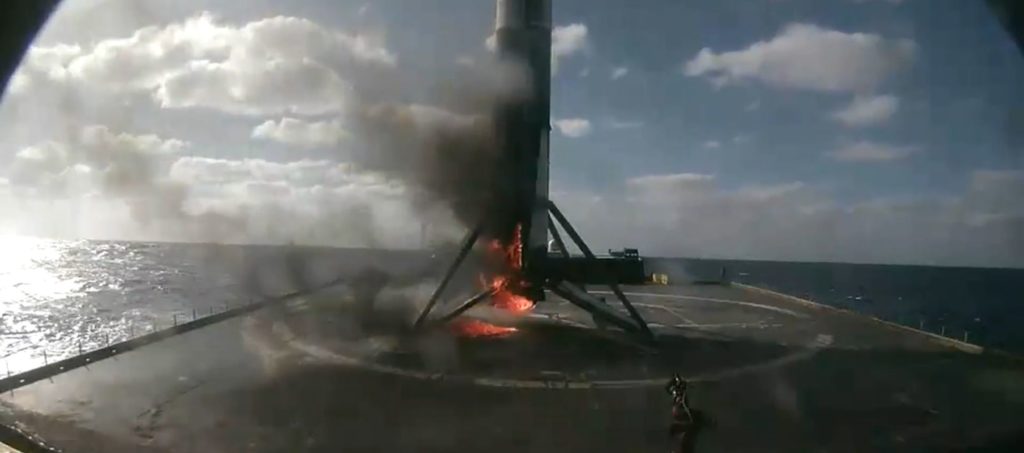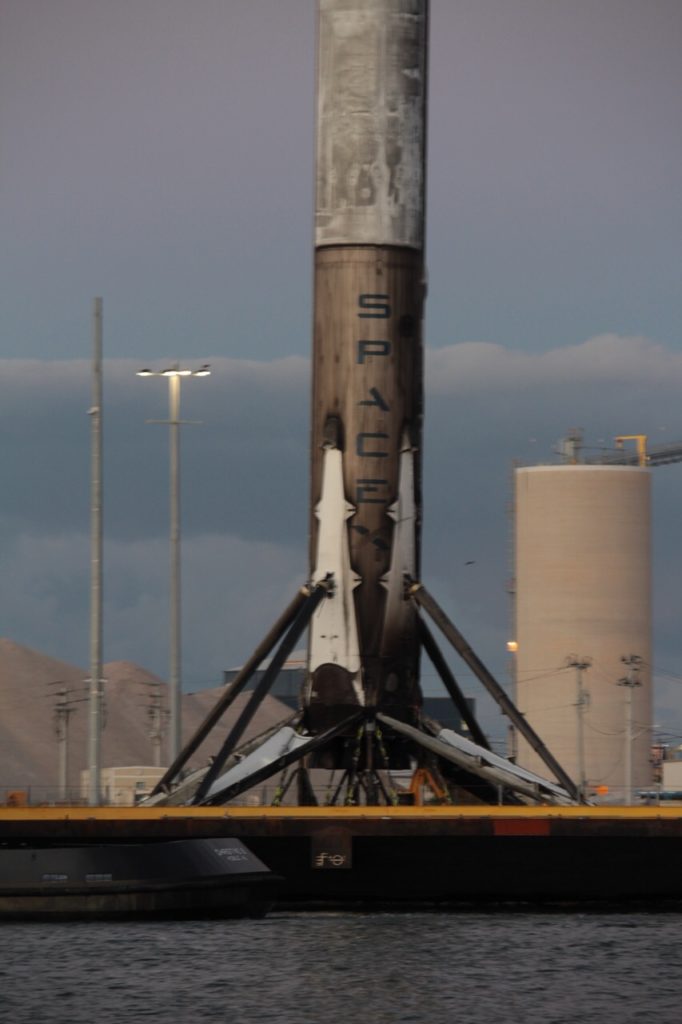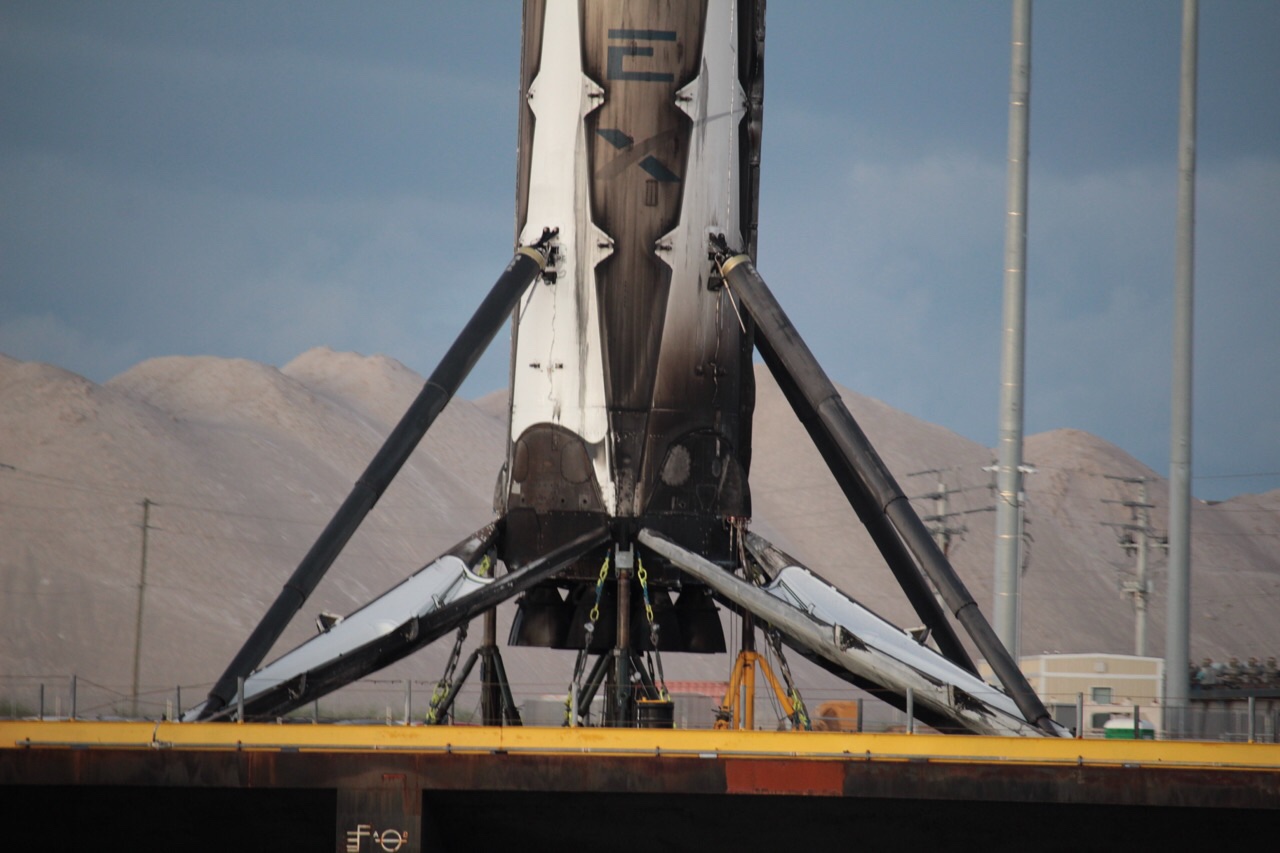
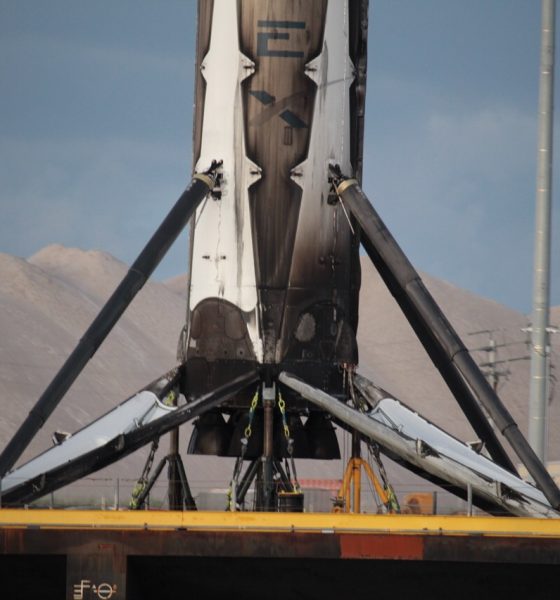
News
SpaceX’s “toasty” Falcon 9 booster arrives back at port [Photo Gallery]
The SpaceX steamroller continues to roll on, and the company’s recent launch of KT Sat’s Koreasat 5A satellite is no exception. The 16th Falcon 9 of 2017 took flight from Kennedy Space Center on October 30 and successfully placed its payload into a high-energy geostationary transfer orbit. Before the satellite had even separated from the second stage of Falcon 9, first stage 1042 had already successfully landed aboard SpaceX’s East coast drone ship OCISLY. The floating landing pad extinguished a small fire that was seen creeping up the booster.
Barely 72 hours later, the drone ship and its Falcon 9 cargo arrived back at Port Canaveral, docking soon after. Launch photographer Tom Cross was on scene to capture the booster’s return home.
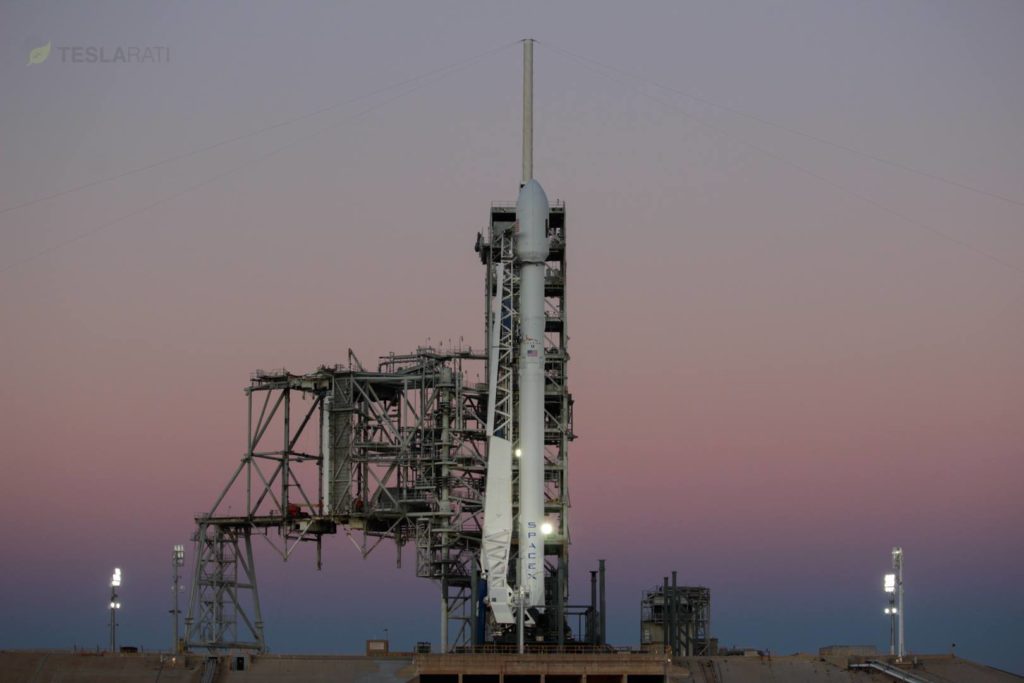
In a wonderful coincidence, Tom was able to photograph the rocket at dawn before it launched, and later at dusk as it arrived aboard OCISLY. (Tom Cross/Teslarati)
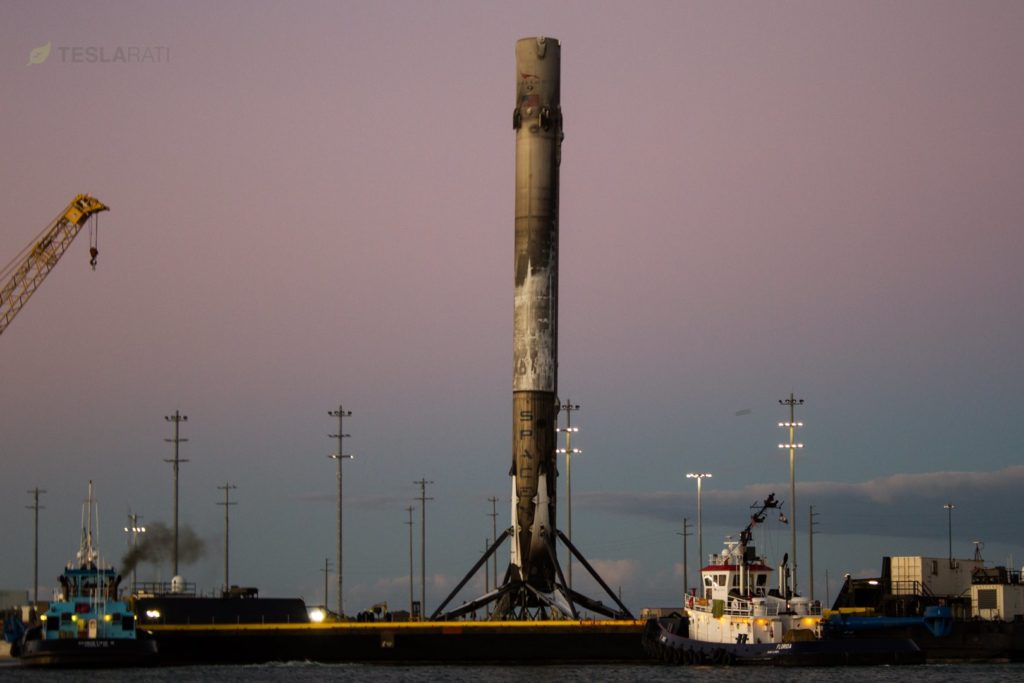
Falcon 9 1042 arrived at Port Canaveral on the evening of November 2nd, and was welcomed home with a beautiful Floridan sunset. (Tom Cross/Teslarati)
Closeup shots serve as evidence of booster 1042’s apparent burn trauma, although it is almost certainly worse than it looks. A number of common operations follow each booster landing, and one of the most important sequences involves emptying residual propellant and depressurizing the rocket’s fuel tanks. This is accompanied by the expulsion of remaining TEA-TAB reserves, a volatile compound used to ignite Falcon 9’s Merlin 1D engines during launch and recovery. TEA-TAB is pyrophoric, meaning it spontaneously catches fire when exposed to your run of the mill air, a decidedly human-unfriendly feature. The fires that occur after successful landings are thus best described as intentional and (mostly) controlled, and SpaceX’s drone ships are equipped with water guns in the event that things get a bit too spicy.
- What a beautiful day for a rocket landing! (SpaceX)
- 1042’s propellant purge became increasingly toasty… (SpaceX)
- And the booster finally got some respite from the fire, thanks to OCISLY’s water gun. (SpaceX)
Despite the small fire, the booster looks to be in great condition.
- Koreasat 5A was a relatively small payload and thus Falcon 9 1042 is likely in decent condition. (Tom Cross/Teslarati)
- The faded soot on the lower right of the booster is the only evidence of the fire captured during the livestream. (Tom Cross/Teslarati)
- (Tom Cross/Teslarati)
- (Tom Cross/Teslarati)
Tom waited patiently as the the sun set and tugboats swarmed to dock the unwieldy drone ship. The dock’s powerful night lights came into full effect and provided an opportunity for some final beauty shots of the gritty booster and industrial surroundings.
- (Tom Cross/Teslarati)
- (Tom Cross/Teslarati)
- (Tom Cross/Teslarati)
After a brief nap aboard OCISLY, SpaceX’s recovery crew wasted no time craning the toasty Falcon 9 core onto dry land, where workers began removing landing legs to prepare the rocket for transport.
Another landing leg removed. It appears that this might the 4th one to come off. pic.twitter.com/QSYdlAR4NQ
— Nathan Barker (@NASA_Nerd) November 3, 2017
SpaceX is clearly building confidence with their recovery procedures, and 1042’s journey has been exceptionally fast and efficient. With 19 successful recoveries now under the company’s belt, the company’s growing expertise is readily apparent, and the clockwork-like nature of their refined processes will benefit SpaceX immensely as it pursues ever-higher launch cadences. With multiple major SpaceX customers expressing newfound interest in reused rockets in the last two weeks alone, the demand for recovered boosters will likely continue to grow, and every successful recovery and commercial reuse is a concrete step along the path to rapid and complete reuse.

News
Tesla FSD fleet is nearing 7 billion total miles, including 2.5 billion city miles
As can be seen on Tesla’s official FSD webpage, vehicles equipped with the system have now navigated over 6.99 billion miles.

Tesla’s Full Self-Driving (Supervised) fleet is closing in on almost 7 billion total miles driven, as per data posted by the company on its official FSD webpage.
These figures hint at the massive scale of data fueling Tesla’s rapid FSD improvements, which have been quite notable as of late.
FSD mileage milestones
As can be seen on Tesla’s official FSD webpage, vehicles equipped with the system have now navigated over 6.99 billion miles. Tesla owner and avid FSD tester Whole Mars Catalog also shared a screenshot indicating that from the nearly 7 billion miles traveled by the FSD fleet, more than 2.5 billion miles were driven inside cities.
City miles are particularly valuable for complex urban scenarios like unprotected turns, pedestrian interactions, and traffic lights. This is also the difference-maker for FSD, as only complex solutions, such as Waymo’s self-driving taxis, operate similarly on inner-city streets. And even then, incidents such as the San Francisco blackouts have proven challenging for sensor-rich vehicles like Waymos.
Tesla’s data edge
Tesla has a number of advantages in the autonomous vehicle sector, one of which is the size of its fleet and the number of vehicles training FSD on real-world roads. Tesla’s nearly 7 billion FSD miles then allow the company to roll out updates that make its vehicles behave like they are being driven by experienced drivers, even if they are operating on their own.
So notable are Tesla’s improvements to FSD that NVIDIA Director of Robotics Jim Fan, after experiencing FSD v14, noted that the system is the first AI that passes what he described as a “Physical Turing Test.”
“Despite knowing exactly how robot learning works, I still find it magical watching the steering wheel turn by itself. First it feels surreal, next it becomes routine. Then, like the smartphone, taking it away actively hurts. This is how humanity gets rewired and glued to god-like technologies,” Fan wrote in a post on X.
News
Tesla starts showing how FSD will change lives in Europe
Local officials tested the system on narrow country roads and were impressed by FSD’s smooth, human-like driving, with some calling the service a game-changer for everyday life in areas that are far from urban centers.

Tesla has launched Europe’s first public shuttle service using Full Self-Driving (Supervised) in the rural Eifelkreis Bitburg-Prüm region of Germany, demonstrating how the technology can restore independence and mobility for people who struggle with limited transport options.
Local officials tested the system on narrow country roads and were impressed by FSD’s smooth, human-like driving, with some calling the service a game-changer for everyday life in areas that are far from urban centers.
Officials see real impact on rural residents
Arzfeld Mayor Johannes Kuhl and District Administrator Andreas Kruppert personally tested the Tesla shuttle service. This allowed them to see just how well FSD navigated winding lanes and rural roads confidently. Kruppert said, “Autonomous driving sounds like science fiction to many, but we simply see here that it works totally well in rural regions too.” Kuhl, for his part, also noted that FSD “feels like a very experienced driver.”
The pilot complements the area’s “Citizen Bus” program, which provides on-demand rides for elderly residents who can no longer drive themselves. Tesla Europe shared a video of a demonstration of the service, highlighting how FSD gives people their freedom back, even in places where public transport is not as prevalent.
What the Ministry for Economic Affairs and Transport says
Rhineland-Palatinate’s Minister Daniela Schmitt supported the project, praising the collaboration that made this “first of its kind in Europe” possible. As per the ministry, the rural rollout for the service shows FSD’s potential beyond major cities, and it delivers tangible benefits like grocery runs, doctor visits, and social connections for isolated residents.
“Reliable and flexible mobility is especially vital in rural areas. With the launch of a shuttle service using self-driving vehicles (FSD supervised) by Tesla in the Eifelkreis Bitburg-Prüm, an innovative pilot project is now getting underway that complements local community bus services. It is the first project of its kind in Europe.
“The result is a real gain for rural mobility: greater accessibility, more flexibility and tangible benefits for everyday life. A strong signal for innovation, cooperation and future-oriented mobility beyond urban centers,” the ministry wrote in a LinkedIn post.
News
Tesla China quietly posts Robotaxi-related job listing
Tesla China is currently seeking a Low Voltage Electrical Engineer to work on circuit board design for the company’s autonomous vehicles.

Tesla has posted a new job listing in Shanghai explicitly tied to its Robotaxi program, fueling speculation that the company is preparing to launch its dedicated autonomous ride-hailing service in China.
As noted in the listing, Tesla China is currently seeking a Low Voltage Electrical Engineer to work on circuit board design for the company’s autonomous vehicles.
Robotaxi-specific role
The listing, which was shared on social media platform X by industry watcher @tslaming, suggested that Tesla China is looking to fill the role urgently. The job listing itself specifically mentions that the person hired for the role will be working on the Low Voltage Hardware team, which would design the circuit boards that would serve as the nervous system of the Robotaxi.
Key tasks for the role, as indicated in the job listing, include collaboration with PCB layout, firmware, mechanical, program management, and validation teams, among other responsibilities. The role is based in Shanghai.
China Robotaxi launch
China represents a massive potential market for robotaxis, with its dense urban centers and supportive policies in select cities. Tesla has limited permission to roll out FSD in the country, though despite this, its vehicles have been hailed as among the best in the market when it comes to autonomous features. So far, at least, it appears that China supports Tesla’s FSD and Robotaxi rollout.
This was hinted at in November, when Tesla brought the Cybercab to the 8th China International Import Expo (CIIE) in Shanghai, marking the first time that the autonomous two-seater was brought to the Asia-Pacific region. The vehicle, despite not having a release date in China, received a significant amount of interest among the event’s attendees.
